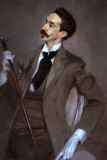From:
Marcel PROUST, Correspondance
(Kolb, Philip,
Ed. –Plon, 1993)
(Frontpage)

Count
Robert de Montesquiou
poet
and art critic
(1855-1921)
|

Léon
Delafosse
pianist
and composer
(1874-1951) |
 Antoine
de la Gandara
portrait
painter
(1861-1917)
Antoine
de la Gandara
portrait
painter
(1861-1917) |
English
(translation)
"(…)
Avant de se brouiller avec Delafosse, Montesquiou s'était démené
pour le faire entendre dans le monde, notamment chez Mme Lemaire et chez
Mme de Pourtalès. Estimant que le pianiste [Delafosse] l'avait
payé d'ingratitude pour sa peine, le Comte prit sa revanche en écrivant
un portrait satyrique du jeune homme en même temps que celui d'un
autre de ses protégés disgraciés, le peintre Antoine
de La Gandara, Delafosse y figurant comme peintre, La Gandara comme musicien
[renversé de leurs rôles réels] sous le nom de "Gambara".
Ces deux portraits parurent d'abord, sous le titre De l'arrivisme au
muflisme [1]
dans le Gil Blas du 20 octobre 1910; cet article est repris dans Têtes
d'expression (1912), aux pages 261 à 275. Proust se souviendra de
ces événements à propos des rapports du baron de Charlus
et du violoniste Morel."

French
(original)
"(…)
Before the breakup with Delafosse, Montesquiou had been struggling to get
him heard in the world, in particular with Mme Lemaire and Mme de Pourtalès.
Figuring the pianist [Delafosse] had been ungracious for his troubles,
the Count took his revenge at the same time by lampooning him in a caricature
of the young man and that of another of his followers whom had been disgraced,
the painter Antoine de la Gandara, Delafosse appearing there as painter,
La Gandara as musician [reversed from their actual roles] under the name
of "Gambara". These two portraits appeared initially, under the title "Of
ambition towards muflisme" [1]
in le Gil Blas of October 20, 1910; this article is included in Têtes
d'expression (1912), on pages 261 to 275. Proust remembered
these events in connection with the reports of the baron de Charlus and
violinist Morel."

Note:
1) "Muflisme," as best I
understand it, is a term coined by of Gustave Flaubert in describing art
and artists who love ignorance, impertinence, contempt for greatness, love
of mediocrity, banality and no ambition. France was, for Flaubert, entering
an "era of the muflisme".
Ouch!
Gustave Flaubert (1821-1880) French
novelist of the realist school, best-known for Madame Bovary (1857), a
story of adultery and unhappy love affair of the provincial wife Emma Bovary.
A perfectionist, Flaubert didn't make distinctions between beauty and ugly
subjects. Though he is grouped with the Realist, he himself, hated that
distinction.


By: Natasha
Wallace
Copyright 1998-2003 all rights reserved
Created 8/5/2003
